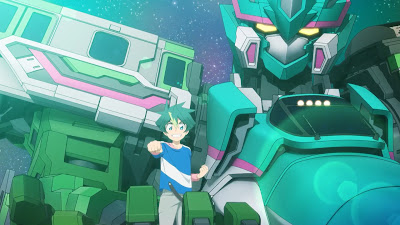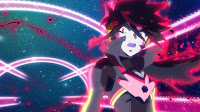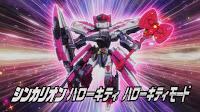Some years after the conflict with the Kitoralsus, the Shinkalion pilots have gone their separate ways and the Ultra Evolution Institute have continued their studies - creating the new generation of transforming robot "Shinkalion Z" as well as the Zailiners, conventional trains that can transform into powerful armaments.
When the Earth is threatened once more by an alien race known as the Teoti, a new team of Shinkalion drivers is formed. Leading them is Shin Arata, a young boy obsessed with the unsolved mysteries of the universe. Together with the Ultra Evolution Institute's gifted young mechanic Abuto Usui, they meet Shinkalion drivers from across Japan. However as the the Teoti make their play to take the planet they claim is rightfully theirs, Shin and Abuto's friendship will be put to the ultimate test.
Like most sequels to a toy-oriented show, to begin with Shinkalion Z is very much "out with the old and in with the new". While the history to the original series is still there and integral to how Shinkalion Z builds its own story, it's all about its brand-new cast and brand-new robots. In some ways this might actually be for the best as it helps Shinkalion Z try to build its own identity without too much reliance on what came before it, as well as allowing new viewers to drop in without too much trouble. Then once it's been able to establish its footing links to the previous series become far more prevalent, with veteran cast members dropping in either in guest spots or as recurring characters. It's never just about nostalgia though, with each returning character serving a very clear purpose and never outstaying their welcome. Original series protagonist Hayato only appearing in a single episode is the perfect example of this, and even then it's something the writers make the audience wait for.
Of course it certainly isn't hard to draw comparisons between the two series though, as for the most part both the broad strokes of the story and the character archetypes remain very much the same. Whereas the original series had obsessive train nerd Hayato Hayase, Shinkalion Z has obsessive conspiracy nut Shin Arata. Shin's passion might have quite the same charm or relevance as Hayato's, the idea of his passion helping to unite people is just as prevalent both as a plot point and a value viewers would be able to take away from the series. A similar level of research and thought has been put into his bits of trivia too, so there's still some sense of education to it as well as being just for laughs. That isn't to say Shinkalion Z is completely devoid of train facts though – it's just that he comes into it from a point of learning much like the audience themselves.
However as archetypal as Shin may be what makes him work is Abuto, who at the beginning of the series is presented as a mechanic without the aptitude to be a pilot himself. Over the first portion of the series we see their friendship develop, with them each relying on the other to assist with the things they can't do themselves. This development is done so well that when it's completely shattered at the plot's first major turning point, it's such a shattering revelation that it's a conflict that underpins the rest of the series. Whereas the first Shinkalion had Seiryu being pulled away from the "bad" side, Shinkalion Z completely flips that and have Abuto turn to the dark side. It isn't an arc that only lasts a few episodes either, instead dominating the series and easily becoming it's biggest emotional drive. Even with so much going on around it with a multitude of characters, Shinkalion Z's strongest asset is these two.
But like the original series there are plenty more Shinkalion pilots to go with them, each one introduced as the story goes along. This fact alone gives Shinkalion Z a rather sizeable cast to work with, and that's without factoring in all the other non-pilot supporting characters there are to go along with them. While each new pilot has their own introductory episode and gimmick (Hanabi is a budding guitarist, Taiju enjoys nature, Ginga an idol star etc.), the majority of them do very little to step outside of a supporting role. Shinkalion Z very much follows its predecessor in setting up a core trio of pilots (in this case Shin, Hanabi and Taiju), with the rest really just an excuse to add more mecha (i.e. toys) into the mix. While none of them are especially bad per se, they often can just be boiled down to one basic character trait or come across as pale imitations of their previous series equivalents (many of whom weren't always that notable either). The concept of having all these pilots dotted around different prefectures in Japan remains though, ensuring that Shinkalion Z keeps some of that real-world education feel even if the railway otaku element of it has been downplayed.
Taking the place of the Kitoralsus in this story are the Teoti – an advanced alien race that previously lived on the Earth and have returned to reclaim the planet. While the finer details might not be quite the same as the Kitoralsus, the broad strokes of their origin remain very similar. It's the same idea of humanity defending back against their attacks, but at the same time trying to develop a dialogue in the hopes that they can work together to find a solution. This is perhaps why the surviving Kitoralsus are the more prominent returning characters as opposed to the older pilots, as they are an example of what this new team should be working toward with the Teoti. Though the individual Teoti might not be as interesting character-wise compared to the Kitoralsus, there is a lot of power play amongst them that prevents them from ever being boring. It's the direct conflict between Shin and Abuto that does the majority of the legwork as the story develops, but there is a lot of great backstory behind it that helps elevate them beyond a different riff on the same idea. Unfortunately even with the show's respectable episode count, so much time is spent on the Shin/Abuto conflict that the overall situation with the Teoti isn't really resolved. It's enough to give the series a happy ending, but it could definitely do with a movie to bring everything together and end this chapter on a properly satisfying note.
It's also unfortunate that Shinkalion Z really doesn't do that much to differentiate itself from the original in terms of it's biggest selling point – the robots. Like the original the show uses CGI models for both the Shinkalion and enemy units, with fights primarily taking place in containment field arenas. The first episode raises the hope that this latter element might have been dropped in favour of something a little different, but those as seen dashed as familiarity settles in. That ultimately that's the problem – the familiarity. Granted the use of real-life Shinkansen doesn't give the show a whole lot to work with in terms of variation, but the designs of the Shinkalion Z, as well as their hierarchy, are so similar to the original that it feels like there's barely any innovation. The use of the Zailiners as support units is a good concept, but the potential just isn't maximized. It's also propped up by a rather weak QR code gimmick, while probably works really well for the toys themselves (particularly Z’s own gimmick robot Smat) but isn't quite as captivating in the show itself. The levels of stock footage and lengthy transformation sequences is both similar to the original and standard for a show of this kind, but again it can bring the pace of episodes to a grounding halt when multiple units are transforming one by one.
One of the stranger aspects of the original series was the appearance of Vocaloid sensation Hatsune Miku as a recurring character, and while the sequel doesn’t return to the (voice) banks of virtual idoldom it does included a similarly surprising character. This time it's Maetel – the iconic protagonist from Leiji Matsumoto's Galaxy Express 999 and related spin-offs. Much like Miku the character has been reworked to fit the Shinkalion universe, but is instantly recognizable as Maetel even to those who might not be all that familiar with the works of Matsumoto. It's a fantastic tribute to one of the most renowned of railway-related manga, bringing the character to a whole new audience. Though much like Miku she may not be a major player in the story, Maetel is well-weaved into its progression – and thanks to that comes off as a lot more memorable than some of the more prominent Shinkalion drivers that appear.
This isn't the only piece of pop culture Shinkalion Z has to play with, and with the airing of the series roughly coinciding with the release of Evangelion 3.0 + 1.0: Thrice Upon a Time of course there's another episode featuring Shinkalion's wonderfully weird parallel universe Evangelion and 500 TYPE EVA. The original show's episode presented a more positive version of Shinji Ikari and that continues here as he matures into an almost mentor-like role, guiding Shin the same way he previously helped guide Hayato. This episode also features a heavy dose of Gendo Ikari, similarly remoulded into a more comedic figure as the story plays up his mannerisms (as well as the dourness of Neon Genesis Evangelion in general) for laughs. It's another wonderful episode that might even manage surpass the one from the first series, acting as another wonderful tribute to the series that feels all the more relevant now that it's finally reached its end. But Shinkalion Z doesn't just stop at Evangelion either, with an even bigger piece of pop culture phenomenon getting in on the action as well. The existence of a real-life Hello Kitty Shinkansen meant that she was also fair game to appear in the show, occurring in another wonderfully absurd episode that skirts the line of the show's internal logic. Once again Shinkalion gives it all when it comes to tributes, to the point where its no wonder that these elements manage to attract headlines even if the franchise itself doesn't get the worldwide acknowledgement it often deserves.
While Shinkansen Robo Henkei Shinkalion Z is able to follow its predecessor in being more than just an obvious toy commercial show, it also lacks a lot of the charm that made the original truly special. The storyline has been changed up just enough that Z can't be accused of simply being a rehash, but by largely following the same beats it doesn’t take much to start drawing comparisons. That said, the dynamic between Shin and Abuto is enough to keep the show interesting even if many of the elements and characters don't stand out as much. Shinkalion Z isn't quite the time investment the original was, but given these critiques maybe that's a good thing.
















No comments:
Post a Comment